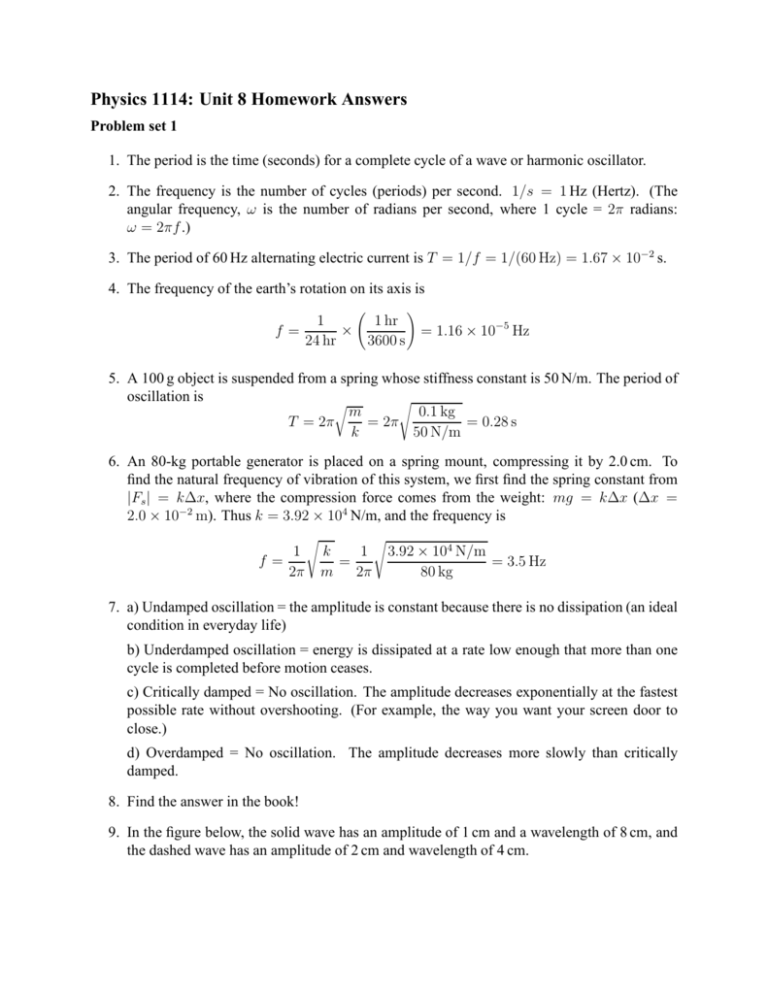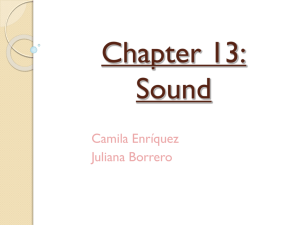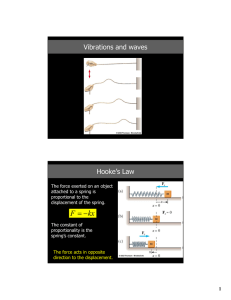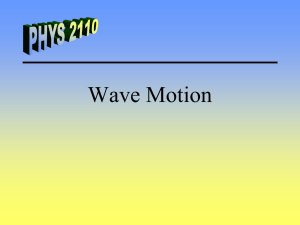Physics 1114: Unit 8 Homework Answers
advertisement

Physics 1114: Unit 8 Homework Answers Problem set 1 1. The period is the time (seconds) for a complete cycle of a wave or harmonic oscillator. 2. The frequency is the number of cycles (periods) per second. 1/s = 1 Hz (Hertz). (The angular frequency, ω is the number of radians per second, where 1 cycle = 2π radians: ω = 2πf .) 3. The period of 60 Hz alternating electric current is T = 1/f = 1/(60 Hz) = 1.67 × 10−2 s. 4. The frequency of the earth’s rotation on its axis is 1 1 hr × f= 24 hr 3600 s ! = 1.16 × 10−5 Hz 5. A 100 g object is suspended from a spring whose stiffness constant is 50 N/m. The period of oscillation is s r m 0.1 kg = 2π = 0.28 s T = 2π k 50 N/m 6. An 80-kg portable generator is placed on a spring mount, compressing it by 2.0 cm. To find the natural frequency of vibration of this system, we first find the spring constant from |Fs | = k∆x, where the compression force comes from the weight: mg = k∆x (∆x = 2.0 × 10−2 m). Thus k = 3.92 × 104 N/m, and the frequency is 1 f= 2π s k 1 = m 2π s 3.92 × 104 N/m = 3.5 Hz 80 kg 7. a) Undamped oscillation = the amplitude is constant because there is no dissipation (an ideal condition in everyday life) b) Underdamped oscillation = energy is dissipated at a rate low enough that more than one cycle is completed before motion ceases. c) Critically damped = No oscillation. The amplitude decreases exponentially at the fastest possible rate without overshooting. (For example, the way you want your screen door to close.) d) Overdamped = No oscillation. The amplitude decreases more slowly than critically damped. 8. Find the answer in the book! 9. In the figure below, the solid wave has an amplitude of 1 cm and a wavelength of 8 cm, and the dashed wave has an amplitude of 2 cm and wavelength of 4 cm. Displacement (cm) 2 1 0 2 6 10 14 18 -1 -2 Distance (cm) Problem set 2 1. Finding the length of a pendulum with a given period: We have to isolate L algebraically from s L T = 2π g Squaring both sides gets rid of the square root: T 2 = 22 π 2 L g Then divide both sides by 4π 2 and multiply by g: L= gT 2 4π 2 For T = 1.0 s, on the earth L = 0.248 m, and on the moon L = 4.1 × 10−2 m (gmoon = 1.63 m/s2 ) 2. The (linear) Superposition principle: When waves intersect in a linear medium, their amplitudes add linearly, resulting in interference (constructive or destructive). A medium is linear if the speed of the waves is constant and is the same for all frequencies. 3. When two waves that are in phase meet in time and space, the result will be constructive interference (the overlapping of two crests or two troughs). (Destructive interference results when the waves are out of phase, i.e., a crest of one wave overlapping a trough of the other wave.) 4. A standing wave is a wave that reflects back and forth, creating a steady interference pattern of nodes and antinodes. (The aspect of being “steady” is a key concept.) 5. Standing waves are produced by interference. 6. A sound source with a frequency of 800 Hz moves at 50 m/s. Find the Doppler-shifted frequency for a stationary observer if the source approaches and if it is moving away. (The speed of sound in air is 334 m/s.) For a source moving toward the observer, the observed frequency fo is fo = 1 1− vsource vsound fsource = 1 1− 50 m/s 334 m/s 800 Hz = 941 Hz For a source moving away from the observer, the observed frequency fo is fo = 1 1+ vsource vsound fsource = 1 1+ 50 m/s 334 m/s 800 Hz = 696 Hz 7. If the speed of sound in the body is about 1.5 × 103 m/s and you want to resolve features that are 1.5 mm to 0.15 mm in size, what is the range of frequencies needed? In order to resolve the features, the wavelength has to be shorter than the size of features: shorter wavelengths resolve smaller features. Using the relationship v = f λ, or f = v/λ, we find that f = 1 MHz for λ = 1.5 mm and f = 10 MHz for λ = 0.15 mm. Problem set 3 1. Light waves have the same relationship between speed, frequency and wavelength as other waves: c = f λ (the symbol for the speed of light is usually c instead of v). So a red light whose wavelength is 6.8 × 10−7 m (680 nm) has a frequency of f = c/λ = (3.0 × 108 m/s.)/(6.8 × 10−7 m) = 4.41 × 1014 Hz (or 441 THz). 2. A tuning fork vibrating at 600 Hz in water produces sound waves 8.2 ft (= 2.5 m) long. The speed of sound in water (the wave speed) is found from v = f λ = (600 Hz)(2.5 m) = 1500 m/s 3. The frequency range of normal hearing for humans is 20 Hz to 20 kHz. The range decreases with age, especially the upper limit. 4. A sound intensity of 1.0 W/m2 will damage the ear. The sound intensity level in dB (deciBel) is SL = 10 log(I/Io ). (Io = 1.0 × 10−12 W/m2 ) 1.0 W/m2 SL = 10 log 1.0 × 10−12 W/m2 ! = 120 dB 5. Heavy traffic produces a sound intensity of 0.003 W/m2. Find the sound intensity in dB: 0.003 W/m2 SL = 10 log 1.0 × 10−12 W/m2 ! = 94.8 dB 6. How many times more intense is a 100 dB sound than a 60 dB sound? (Convert to W/m2 and compare.) The 100 dB sound is 104 times larger in intensity than the 60 dB sound. To find the intensity corresponding to a sound level, we need to invert the equation SL = 10 log(I/Io ) I SL = log 10 Io To remove the log function, we have to raise both sides to powers of 10: 10SL/10 = 10log(I/Io ) By definition, 10log(I/Io ) = I/Io [like arcsin(sinθ) = θ], so we have 10SL/10 = I Io I = Io 10SL/10 Then I1 = (1.0 × 10−12 W/m2 )1010 = 1 × 10−2 W/m2 and I2 = (1.0 × 10−12 W/m2 )106 = 1 × 10−6 W/m2 . (Also see Example 14.5 on page 489 of the book.) 7. Resonance is the maximum vibration that occurs when a system is driven at a natural frequency. A simple harmonic oscillator has only one resonant frequency. More complex systems, like a string tied at both ends, can have many resonant frequencies. 8. Draw sketches for the fundamental, 2nd and 3rd harmonics for strings and for pipes with one end closed and with both ends open. Indicate the relationship between λ (wavelength) and L (length of pipe or string) for each. For the string sketches, see page 466 in the book, for the pipes see page 504. 9. (There was a mistake in this question: A closed-end pipe does not have second harmonic! The first overtone is the third harmonic!) A certain organ pipe is 0.60 m long and has one closed end. Find the frequency of the harmonic mode (i.e., the first overtone). Assume the speed of sound in air is 334 m/s. For a closed-end pipe, v fm = m 4L (m = 1, 3, 5, ...) 334 m/s f3 = 3 4(0.60 m) ! = 417 Hz 10. A 2.0-meter organ pipe, open at both ends, is vibrating in the first overtone mode. What should be the length of a closed pipe so that its fundamental frequency will be the same? The speed of sound in air is 334 m/s. v fn = n (n = 1, 2, 3, ...) 2L ! 334 m/s f2 = 2 = 167 Hz 2(2.0 m) To make a closes-end pipe with a fundamental frequency of f1 = 167 Hz, v f1 = (1) 4L L= v 4f1 ! = 334 m/s 4(167 Hz) ! = 0.5 m











